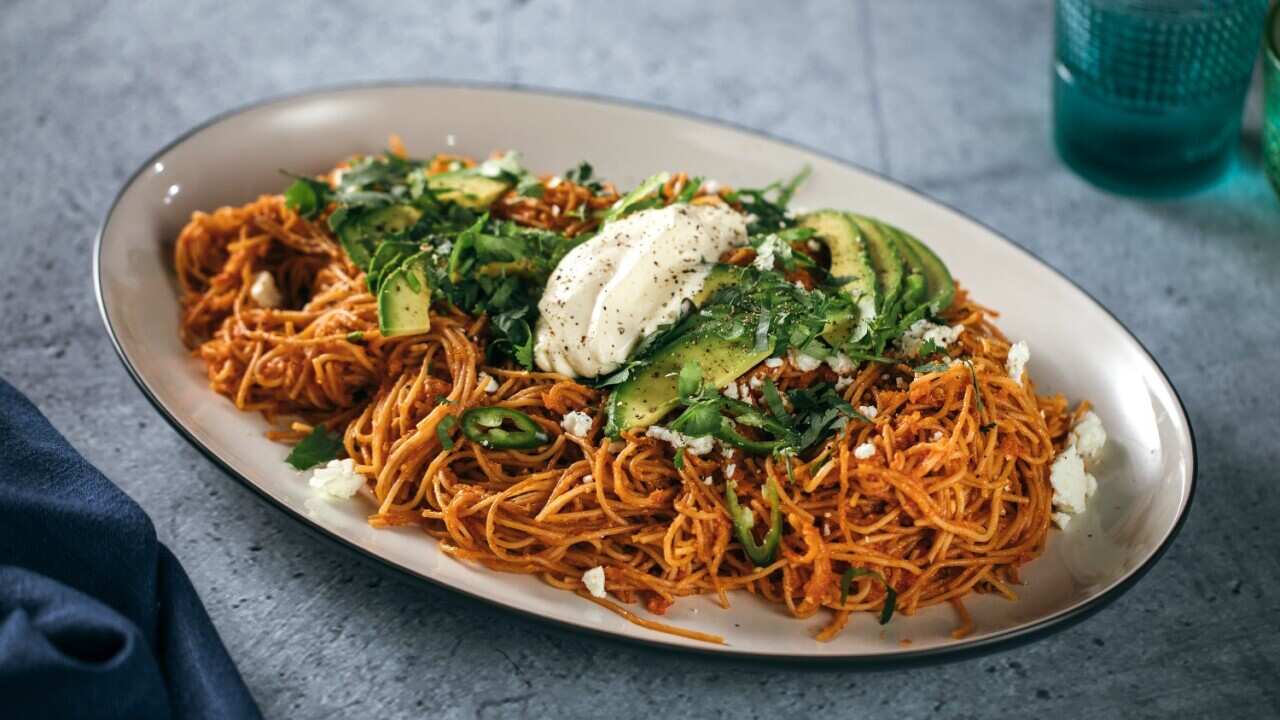Before going to school and working in restaurants, chef first learned hospitality from his parents. “They didn’t work in hospitality; dad worked in a glass factory and mum was at home and the farm, but that’s where I got the bug,” he explains. "All they would do is entertain and cook."
The family's home town of , in the Puglia region of southeastern Italy, was surrounded by tomato fields and olive tree groves, with the Adriatic Sea only a few kilometres away.
It meant that local vegetables, freshly caught seafood and homemade tomato sauce would always find their place on the table when the Esposito's would host massive family gatherings.
The chef has fond memories of his mum making swordfish carbonara and calamarata ai frutti di mare (pasta cooked with tomato and seafood in a paper bag). Both dishes now make frequent appearances at , his restaurant in Melbourne's Fitzroy.
As a kid, he also remembers his dad coming home from work late and cooking pasta straight in the pan with the sauce. But it wasn’t until he started working in local restaurants as a teenager that he would encounter a similar dish.
It was , a specialty of Puglia's capital, Bari, half an hour from where he lived. The chef at the Bari restaurant Esposito worked at, back then, would make it for the staff at the end of the night. “He would do a debrief of the service while cooking, but we could only focus our attention on the pasta he was cooking in a cast-iron pan,” he recalls. “We asked him why it wasn’t on the menu, but the chef said it takes too long to make and that people expect pasta cooked a certain way. I thought that if I ever have a restaurant, I would make it.”
For all’assassina, the dried spaghetti is put straight into the pan with garlic and chilli, and a tomato-based sauce. “You cook the pasta just like you’d cook risotto, the method is called risottatura, risotto-style pasta in a way,” says Esposito.
High heat and a cast-iron pan are essential to ensure parts of the pasta is cooked properly.
“It’s the way it’s cooked that makes the dish magical. They call it the assassina because it’s like killing the dish, doing it in a different way not done before,” says Esposito. “Instead of getting lost in water, the starch of the pasta gets in the sauce, binds the pasta and gives it a texture second to none.”
in a Bari restaurant. It even has a , the Accademia dell’Assassina.
Esposito, who also owns , first started making the dish for the staff meals in 2020 at Rosella, and decided to add it to the menu once .
It’s the way it’s cooked that makes the dish magical. They call it the assassina because it’s like killing the dish, doing it in a different way not done before.
“At lunchtime, there isn’t one table that doesn’t have that dish on the table,” he says. “We’re currently redesigning the menu, but this dish is not coming off!”
His version is sprinkled with dehydrated black olives to add another dimension to the dish.
With Esposito describing Rosella as having a strong Southern Italian accent, spaghetti all’assassina feels right at home on the menu alongside dishes like octopus , with sardines and (broad bean purée with chicory).
He even serves the same stracciatella he grew up eating in his hometown of Conversano (with pink pepper and ), after finding out by chance that (ask him for the full story next time you dine at Rosella).
Assassin-style spaghetti (spaghetti all’assassina)
Serves 4
The spaghetti all’assassina dish is not just a simple tomato pasta, it’s spicy, crunchy and a little burnt, too. It’s cooked using the risottatura method which requires a lot of attention during the cooking time. To get the best result, use a heavy cast-iron pan and at least 36cm in diameter – so the pasta strands will fit inside without breaking.
Ingredients
- 2 tbsp tomato paste
- 400 ml passata
- 2 tbsp salt, optional
- 2 medium-sized red chillies, chopped
- 1 garlic clove, whole
- 1 garlic clove, finely diced
- 150 ml extra-virgin olive oil
- 320 g dried spaghetti
Method
- To prepare the stock for cooking the spaghetti, combine 200 ml water, tomato paste and 300 ml passata in a 4-litre stainless steel pot. If the stock needs more seasoning, add salt to taste. Place the pot over medium-high heat and cook until the stock is red and hot (about 5-8 minutes).
- In the cast-iron pan, add chillies, garlic and oil and place over medium heat.
- When the garlic becomes slightly golden, remove the whole garlic clove and increase the heat. Add the remaining 100 ml of tomato passata – be careful, as this will start spitting everywhere (which it should). An apron is highly recommended for this step.
- Once the passata reduces, evenly spread the spaghetti around the pan. The spaghetti will start sticking to the pan after 5 minutes, so carefully dislodge the spaghetti with a wooden spoon – allowing the strands to slightly caramelise on one side. Keep the spaghetti towards the centre of the pan, taking care not to break the strands.
- Slowly add the stock around the edge of the pan, a little at a time, avoiding the spaghetti. Allow the spaghetti to caramelise as the stock reduces. It's okay if some strands stick to the pan – basically, you're “making them suffer”, and you’re the assassin slowly “killing” the pasta. Continue for 8-10 minutes – some parts of the spaghetti will be al dente, while other parts will be crunchy, Remove from pan and serve.








